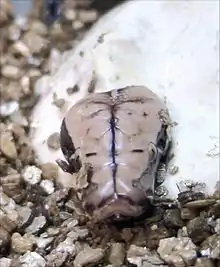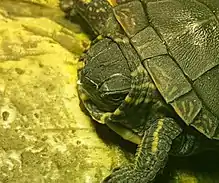Egg tooth
In some egg-laying animals, the egg tooth is a small, sharp, cranial protuberance used by offspring to break or tear through the egg's surface during hatching. It is present in most reptiles, and similar structures exist in monotremes, Eleutherodactyl frogs, and spiders.



Some lizards develop a true tooth that is shed after use; other reptiles and birds generally develop an analogous epidermal horn that is reabsorbed or falls off.
Birds
A mother bird delivers her young encased in an eggshell; an external protective covering consisting of calcium carbonate (CaCO3). The shell protects the chick until it is ready to survive in the outside world. The chick breaks open the shell when it is strong enough and ready. Since the beak and the claws of the bird are not fully developed and cannot penetrate the eggshell, the "egg tooth" is the unusual structure that helps the bird break through the shell. It is only found in emerging chicks and lost soon after hatching, after it is used to penetrate the hard shell that once protected the embryo.[1]
In birds, the process of breaking open the eggshell is commonly referred to as pipping.[2]
Chicks have a pipping muscle on the back of their necks. It is this muscle which gives them the strength to force the egg tooth through the inner membrane of the eggshell.
When a chick becomes too large to absorb oxygen through the pores of its eggshell, it uses its egg tooth to peck a hole in the air sac located at the flat end of the egg. This sac provides a few hours' worth of air, during which the chick breaks through the eggshell to the outside. The egg tooth falls off several days after hatching.
Kiwis lack an egg tooth, instead using their legs and beak to break through a relatively thin eggshell. The superprecocial megapodes possess an egg tooth in their early embryonic development, but instead use their claws during hatching.
Snakes and lizards
Most squamates (lizards and snakes) also lay eggs, and similarly need an egg tooth. Unlike in other amniotes, the egg tooth of squamates is an actual tooth which develops from the premaxilla.
Crocodilians
A baby crocodile has an egg tooth on the end of its snout. It is a tough piece of skin which is resorbed less than two months after hatching. Crocodile eggs are similar to those of birds in that they have an inner membrane and an outer one. The egg tooth is used to tear open the inner membrane; the baby crocodile can then push its way through the outer shell. If conditions are particularly dry that year, the inner membrane may be too tough for the crocodile to break through, and without assistance it will simply die inside the egg. Generally, however, the mother crocodile is there to help free it.[3]
References
| Wikimedia Commons has media related to Egg teeth. |
- Rosenthal, Karen. "The Egg Tooth". Archived from the original on 2013-04-04. Retrieved 2019-07-22.
- "Definition and etymology of "pipping"". Webster's Dictionary. Retrieved 2008-04-03.
- Britton, Adam. "Crocodilian Biology Database - Teeth (Egg tooth)". Florida Museum of Natural History. Archived from the original on 27 December 2004. Retrieved 28 October 2005.
